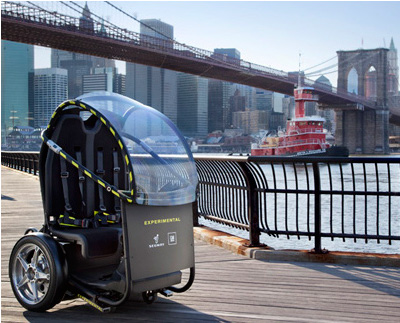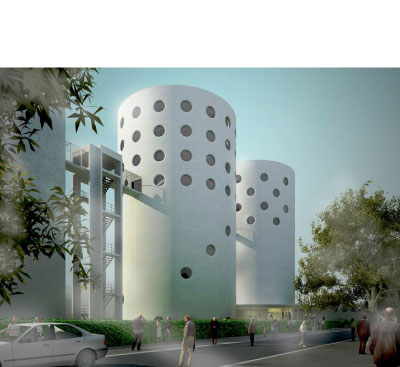Zurich-based Freitag has just added two new messenger bag styles to its collection of industrial accessories: the F76 Leo bag (for 13” laptops) and the F77 Ben bag (for 13” and 15” laptops). Each unisex style is available in eighty different colorways, and the bags’ versatile design allows the user to carry it as a tote, a shoulder bag, or a crossbody messenger bag. Like the label’s other styles, the boldy-colored Leo and Ben are handmade from used seatbelts and truck tarpaulins. They continue Markus and Daniel Freitag’s legacy of durable, water-resistant messenger bags. Freitag’s longtime dedication to repurposing materials will appeal to the eco-conscious customer, while the new bags’ efficient shape and size will please computer-users from bloggers to businessmen. Great bags for bicyclists and commuters, using the Leo or the Ben is a reliable and trendy way to take your work home with you.
(more…)


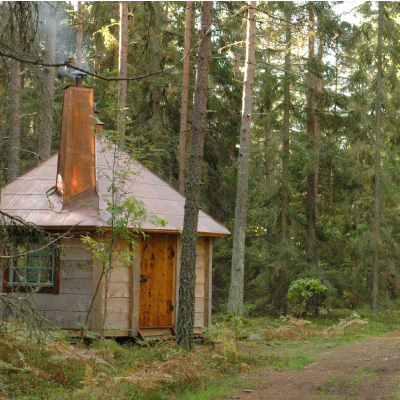
It’s been great to see a growing number of eco-lodges offering a more sustainable holiday alternative surface over the last years. As much as they all deserve recognition for their environmental awareness it’s hard not to get excited when stumbling upon one with that little bit of extra. One like The Wood Hermitage, located in the leafy Holaved forest in the south of Sweden. The Hermitage — surrounded by lakes and the mountain Omberg — has welcomed guests to its spartan facilities since May 2007. Offering simple luxury, the lodge mixes traditional Swedish craftsmanship with Japanese-influenced interior design. The small handcrafted wooden huts and cabins — some of them with grass covered roofs — work in harmony with the surrounding environment. All houses except for the main cabin were built using trees felled by the storms Gudrun and Per in 2005 and 2006. The use of electricity is sparse — there is only enough for running a single 15W light bulb in the kitchen and the solar panel in the bathing house. Both the sauna and the wooden bathtub are wood-fired. On top of such a cozy living space, The Wood Hermitage also embraces the local food trend, with all the food coming from their own garden or nearby farmers.
(more…)

For those looking for an eco-friendly way to get around the city, without actually having to exert extra energy en route, there’s P.U.M.A. Designed by Segway — the company who developed the Segway— and General Motors, P.U.M.A., which stands for Personal Urban Mobility & Accessibility, may just be the solution for eco-conscious urbanites everywhere. Like the Segway, the P.U.M.A. features advanced sensing and dynamic stabilization with a zero turning radius. Unlike its older brother, it includes a domed weatherproof roof and seating for two. Suitable for both city roads and bike lanes, the P.U.M.A. can travel between 25 and 35 mph for twenty-five to thirty-five miles on a single battery charge — which take five to eight hours — making it an ideal vehicle for short commutes. Costing, approximately sixty cents in electricity per charge, and estimated to cost less than most current small cars, the P.U.M.A. is also highly cost-effective. With only one prototype in existence, and no plans to start selling the P.U.M.A. anytime soon, our hopes of owning the perfect clean transportation vehicle will just have to wait. In the meantime, you could always get a bike. We still think those are awesome.

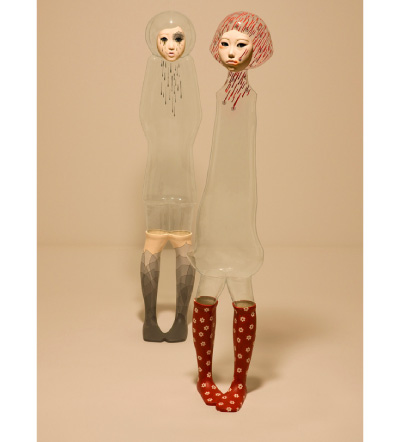
It’s not every day that an artist is able to stake her claim in the art world using an invisible medium. Yet with each pigeon-toed, see-through figure she creates, that is exactly what Korean sculptress, Jin Young Yu has done. Constructed entirely out of a self-formulated PVC (glass and clear plastic just weren’t transparent enough), each invisible man, woman, and child is a three-dimensional examination of hypocrisy, domestic secrets, and the ongoing battle between a private versus public self.
Created in full scale and often standing four feet tall, the translucent sculptures are as awe-inspiring as they are painstakingly conceived. Every limb, smock, and random accoutrement is created individually before being reassembled and woven together with transparent thread, taking Jin Young around forty days to make one figure.
Much like each somber-faced character, the artist has nothing to hide when it comes to sharing her worldview. “My figures express the loneliness of people living today. The transparent body means a perfect shield that makes it possible to hide itself anywhere, while the crying face represents a warning: ‘Don’t come towards me!’ I intend to remind viewers of the loneliness of people in this modern society, where there is little of true communication.” And as for an overall theme? “I want to get away from the plastic smiles and fake facial expressions,” she says. Thus is the essence of Jin Young’s stoic army.
(more…)



In a lineup of socially conscious programming, the Sundance Channel’s “Man Shops Globe” sticks out like a finely manicured sore thumb. While the Newark-based civic crusaders of “Brick City” struggle and strive, “Globe” protagonist Keith Johnson raids far-flung caches of time-weathered furniture to fill Anthropologie’s stores (the show is both a revealing look at high-end retail and an advertisement for the clothing and curios chain). Refreshingly devoid of the made-for-tv attitudes of his reality-show peers (“The Rachel Zoe Project”, “Flipped Out”), Johnson lacks the guile to make himself a pre-packaged star or wax romantic on the provenance his targeted bookcases, tables, and fashionable bric-a-brac. He
calls himself a “treasure hunter”, though he is less Indiana Jones than a pitiless hyena scrounging for ver-di-gris flowerpots and wire bed frames. Naturally you begin to plunder along with him, wondering how that wardrobe from Provence would look under your television. Bookended by socially conscious programming like “Brick City” and “The Lazy Environmentalist”, “Man Shops Globe” comes off as proudly irresponsible–the “finds” that give Johnson a brief contact high are bound for mall stores and not a second is granted to self-conscious grumbling about commercialism, psychological motivations, or anything other than where to find the next watercolor painting or cup of strong coffee. Regardless, at a time when shopping for shopping’s sake is no longer an acceptable pastime, “Man Shops Globe”offers sophisticated, heedless jollies without a credit-card statement. Dig in.
Man Shops Globe premieres Wednesday October 7th.

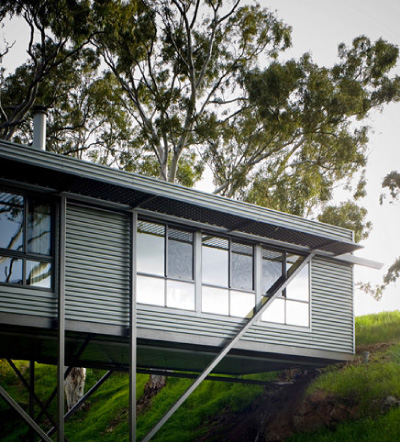
The Bridge House by architect Max Pritchard got a fair amount of press earlier this summer, so we’re a little late to the praise party. But in the interest of giving credit where credit is due, we’d like to gush over this ingenious living/working space that straddles a creek outside of Adelaide, South Australia. Let’s start with money. It only cost $177,000. That’s laughably lower than the average home being published today. Granted, with an area of 110 square meters, Bridge House is relatively small. But a price tag under $200k for such a thoughtfully designed home on a lot this challenging is inspiring: Hey, average non-millionaire, you too could have your house written about in fancy New York City magazines if you hire a clever architect like Mr. Pritchard. Oh, and if you’re ballsy enough to build over a creek’s deep waterhole.
In Australia, they’d call that waterhole a billabong. The clients have a 10-acre site but they wanted their house to be on the bank overlooking the billabong. They didn’t want to significantly alter the gorgeous setting and destroy the billabong, so steel trusses were used to elevate the house. As a commenter on the Web site Archinet reminds us, it’s very reminiscent of an unbuilt project by Craig Ellwood, the influential, yet unlicensed, architect. The best artists always steal, right?

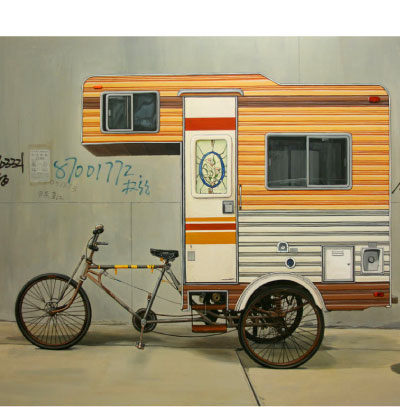
These days, it seems there’s a new eco-invention every week. Maybe you’ve already heard of the solar-powered eco-camper, the vegetable oil-fueled bio-Trekker , or even the Emergency Response Studio. If you have, then there’s no need telling you that the RV no longer has to be that gas guzzler antipode of sustainable travel that it used to. If not – well, now you know. And there’s even more….
Boston-based artist Kevin Cyr has created another type of green RV: the Camper Bike. Secured on a steady three-wheeler the camper is a human-driven sustainable RV that can be taken for a ride by a single pedaler. The inside is still under construction but once finished the Camper Bike will be equipped with the most necessary amenities for a few days on the road, making it a neat alternative holiday house — that is, if you don’t mind traveling solo. On his website Cyr describes the camper as a sculptural art piece, even if it is fully functioning. As such there might be little luck in wishing for one of your own anytime soon. But who knows, if Cyr gets a good response maybe he’ll put the camper into production.
(more…)


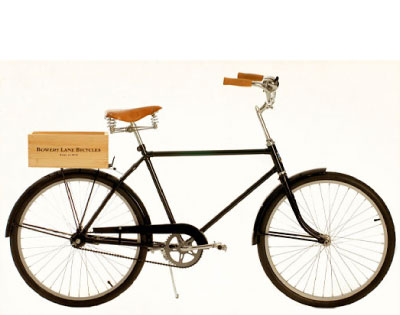
Ah, nothing to fill you with that enticing feeling of freedom like cruising your bike down the block on a grand summer’s day. The wind in your hair, sun in your face, and your fellow commuters’ envious gaze on your exquisite new ride. Because really, what other way to ride a bike than with impeccable style? The people behind Bowery Lane Bicycles, a New York-based family company, have the right idea — and they’re performing it with great finesse.
The retro-style Bowery Lane bikes are handmade in New York out of American steel. The two-wheelers are available in three styles, all of which are locally handcrafted and manufactured and made with eco-friendly parts such as sustainable cork grips. The Broncks Black — the company’s flagship, inspired by a Dutch original — is even made with renewable solar energy, bringing together traditional craftsmanship and sustainable technology. The company was founded with the goal to make affordable bikes that have more to offer than flair and timeless beauty (as if that wouldn’t be enough) and they sure deliver what they set out to do.

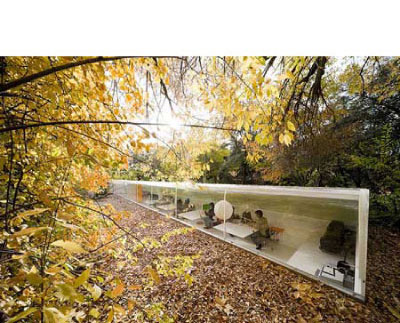
The most common response to the question “What’s your dream home?” is probably something like “A place in the woods, surrounded by nature.” That’s because many of us equate living deep in the forest or high in the mountains with serenity and, if the house is modernist (or better yet, a modernist take on a log cabin!), a sort of rustic sophistication. Think of Frank Lloyd Wright’s Fallingwater; hell, even that vampire family’s house in Twilight. But many of us spend as much or more time at work than we do at home. And many of us work in some of the world’s most demoralizing, low-ceilinged buildings in the busiest and smelliest areas of major cities. So, short of becoming a lumberjack, how should today’s cooped-up white-collar employee dream of escaping his or her miserable workspace? By getting a master’s degree in architecture and applying for a job at Selgascano, a Spanish design firm whose new studio is in the middle of the woods outside Madrid.
(more…)

In between downtown Amsterdam and a newly developed area to the east called IJburg is the island of Zeeburgereiland. Locals mainly think of Zeeburgereiland (loosely translated: “sea person island”) as an inhabitable island with a massive sewage-treatment plant. But not for long. The plant is being relocated, and Zeeburgereiland is becoming prime real estate. Three large silos once used for treating sewage will remain on the island; one of them has already been converted into office space. The city council recently held a competition to determine how to reuse the other two and, in April, announced the winning design: Arons En Gelauff Architects’ Annie MG Schmidt House, a cultural center named after Holland’s most celebrated children’s book author. But if we were running things, it would have gone to NL Architects’ proposal. Why? Look at these pictures.
In their plan, one silo would be adapted into an indoor climbing center. Its walls taper toward the top and ingeniously end at a roof light. The firm envisioned the climbing silo also being used for weddings, birthday parties and church services.
(more…)






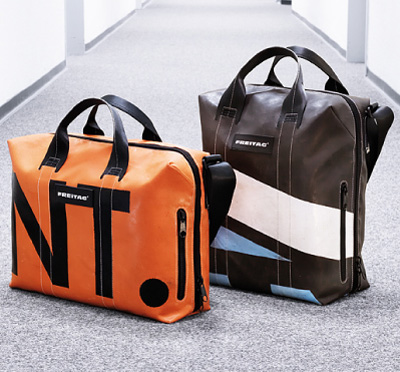
 Facebook
Facebook Permalink
Permalink Digg
Digg Reddit
Reddit LinkedIn
LinkedIn StumbleUpon
StumbleUpon Tumblr
Tumblr

